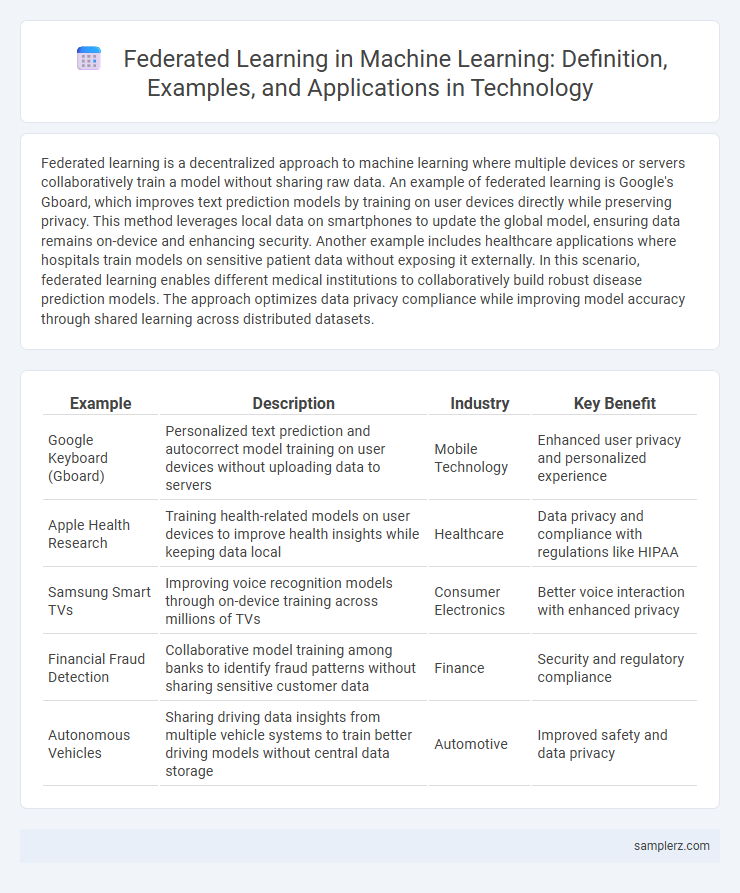Federated learning is a decentralized approach to machine learning where multiple devices or servers collaboratively train a model without sharing raw data. An example of federated learning is Google's Gboard, which improves text prediction models by training on user devices directly while preserving privacy. This method leverages local data on smartphones to update the global model, ensuring data remains on-device and enhancing security. Another example includes healthcare applications where hospitals train models on sensitive patient data without exposing it externally. In this scenario, federated learning enables different medical institutions to collaboratively build robust disease prediction models. The approach optimizes data privacy compliance while improving model accuracy through shared learning across distributed datasets.
Table of Comparison
| Example | Description | Industry | Key Benefit |
|---|---|---|---|
| Google Keyboard (Gboard) | Personalized text prediction and autocorrect model training on user devices without uploading data to servers | Mobile Technology | Enhanced user privacy and personalized experience |
| Apple Health Research | Training health-related models on user devices to improve health insights while keeping data local | Healthcare | Data privacy and compliance with regulations like HIPAA |
| Samsung Smart TVs | Improving voice recognition models through on-device training across millions of TVs | Consumer Electronics | Better voice interaction with enhanced privacy |
| Financial Fraud Detection | Collaborative model training among banks to identify fraud patterns without sharing sensitive customer data | Finance | Security and regulatory compliance |
| Autonomous Vehicles | Sharing driving data insights from multiple vehicle systems to train better driving models without central data storage | Automotive | Improved safety and data privacy |
Introduction to Federated Learning in Machine Learning
Federated learning enables multiple decentralized devices, such as smartphones or IoT sensors, to collaboratively train a shared machine learning model while keeping the data localized and private. This approach minimizes data transfer, enhances privacy, and reduces latency compared to traditional centralized learning systems. Popular applications include personalized keyboard suggestions on mobile devices and health data analysis across hospitals without exposing individual patient records.
Real-World Applications of Federated Learning
Federated learning enables collaborative machine learning models across multiple decentralized devices without sharing raw data, enhancing privacy and security in applications such as healthcare, where hospitals train shared models on sensitive patient data. In the financial sector, this approach allows banks to detect fraudulent transactions by leveraging distributed data while maintaining compliance with data protection regulations. Smart devices like smartphones use federated learning to improve personalized services such as keyboard prediction and voice recognition, optimizing user experience without compromising private information.
Healthcare Use Cases Utilizing Federated Learning
Federated learning enables hospitals to collaboratively train machine learning models on decentralized patient data while preserving privacy, enhancing predictive analytics for disease diagnosis and treatment outcomes. By securely aggregating insights from multiple healthcare institutions, it improves model accuracy without compromising sensitive medical records. This approach accelerates personalized medicine development and optimizes resource allocation in clinical settings.
Federated Learning in Financial Services
Federated learning in financial services enables institutions to collaboratively train machine learning models on decentralized data while preserving customer privacy and complying with strict regulatory requirements. Banks and insurance companies utilize federated learning to enhance fraud detection, risk assessment, and credit scoring by securely sharing insights without exposing sensitive information. This approach reduces data silos, improves model accuracy, and supports real-time decision-making across multiple financial organizations.
Privacy-Preserving AI in Mobile Devices
Federated learning enables mobile devices to collaboratively train machine learning models while keeping user data decentralized and private. By processing data locally on smartphones and sharing only model updates, this approach minimizes risks of sensitive information exposure. Examples include keyboard prediction apps that improve accuracy without transmitting personal typing data to central servers.
Collaborative Learning for IoT Systems
Federated learning enables collaborative learning across IoT devices by allowing multiple edge devices to train a shared machine learning model without exchanging raw data, preserving privacy and reducing bandwidth usage. This decentralized approach leverages local data on smartphones, sensors, and smart home devices to improve models for applications such as predictive maintenance and personalized recommendations. Key platforms implementing federated learning in IoT ecosystems include Google's TensorFlow Federated and Apple's on-device intelligence frameworks.
Federated Learning for Smart Transportation
Federated learning enables smart transportation systems to collaboratively train machine learning models using decentralized data from multiple vehicles and infrastructure sensors without compromising privacy. This approach accelerates data-driven insights for traffic prediction, autonomous driving, and congestion management by aggregating local model updates across edge devices. As a result, federated learning enhances real-time decision-making and safety in intelligent transportation networks while preserving data security.
Enhancing Natural Language Processing with Federated Learning
Federated learning enables natural language processing models to be trained on decentralized data sources such as smartphones and edge devices, preserving user privacy while improving model accuracy. By aggregating updates without sharing raw data, federated learning enhances personalized language models for applications like predictive text, sentiment analysis, and voice assistants. This distributed approach reduces data breaches and complies with data protection regulations, making it a robust solution for NLP advancements.
Edge Computing and Federated Learning Integration
Federated learning enables decentralized model training across distributed edge devices, minimizing data transfer and enhancing privacy by processing information locally. Integration with edge computing leverages on-device computational power to train AI models collaboratively without centralizing sensitive data in the cloud. This approach optimizes real-time analytics, reduces latency, and supports scalable, privacy-preserving applications in IoT networks and smart devices.
Challenges and Future Trends in Federated Learning
Federated learning faces significant challenges such as data privacy preservation, communication efficiency, and model heterogeneity across decentralized devices. Advances in secure multi-party computation and differential privacy aim to strengthen data confidentiality while optimizing bandwidth usage through model compression techniques. Future trends emphasize integrating edge computing, developing personalized federated models, and employing adaptive algorithms to enhance scalability and robustness in heterogeneous environments.

example of federated learning in machine learning Infographic
 samplerz.com
samplerz.com